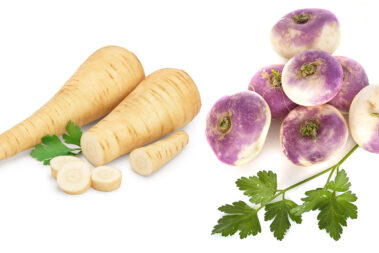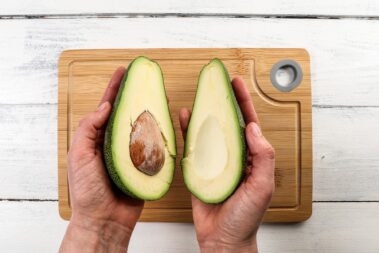For vegans wise to the unhealthy and Earth-damaging effects of standard vegetable oils, olive oil is a popular alternative with a lot of promise.
Yet, despite its popularity, this oil manages to retain some mystery. Everyone who has ever spent time scanning the oil shelves at the grocery store knows what I’m talking about.
There are a LOT of different types of olive oil.
If you’ve ever wondered what the differences are between extra virgin and regular virgin or what cold-pressed or expeller-pressed means, we finally have your answers.
In this article, we will look at the six different types and classifications of olive oil and discuss when to use which kind. We’ll also delve into whether or not this popular oil is as healthy as it is made out to be.
Table of Contents
Is Olive Oil Healthy?
Before we look at the different types of olive oil available, it is important to understand if olive oil is truly for you or not.
Andrea Paul, MD and health advisor to Illuminate Labs, points to the connection between olive oil and the Mediterranean diet to highlight the potential health effects of this popular oil.
“Olive oil is one of the healthiest oils available,” Andrea says, “and a core part of the diet in Mediterranean countries, which is associated with increased lifespan and wellness. It’s rich in antioxidants, phytochemicals, and fatty acids that benefit the body.”
While it is true that olive oil is loaded with health-promoting nutrients, it is also packed with calories from fat.
Registered dietician, Shena Jaramillo, is quick to caution this point.
She says, “One thing to know about olive oil is that while it can offer health benefits, more does not always equal better. Choose what is needed to adequately prepare your dish and no more. In nutrition, enough is as good as a feast. Loading up on olive oil will only lead to excess calories and potentially weight gain.”
Compared to animal fats, however, olive oil is far more forgiving when it comes to weight gain. One study, looking at increased fat consumption over time, found that any increase in animal fat consumption, particularly saturated and trans fats, resulted in weight gain. A similar increase in consumption of plant-based fats, particularly polyunsaturated and monounsaturated, was not associated with significant weight gain(1).
However, studies on the effects of vegetable oil consumption on heart health do show that there is some credence to the advice of not overdoing it when it comes to processed oils. These studies have found that even without weight gain, excess vegetable oil consumption, particularly high linoleic acid oils like safflower but also olive to some degree, are associated with an increased risk of cardiovascular events(2).
If you struggle to consume your oils in moderation, using an oil sprayer during certain applications can help you stay within the recommended 2 to 3 tablespoons per day limit.
The Different Types of Olive Oil
Olive oil can be separated into types based on the extraction method used, its purity, and its flavor profile. Having so many different overlapping categories is one of the reasons it seems like there are a million different types of olive oil.
Keep reading to find out what defines each type and how they should be used.
Extra Virgin Olive Oil
The most flavorful and purest of all the olive oils, extra virgin, or EVOO, is widely considered the healthiest form of this popular oil.
What Makes It Different?
Extra virgin olive oil is always extracted through cold-press methods and never refined, which means the olives are never subjected to high heat. This allows more flavor and color to come through to the final product.
EVOO must also achieve certain high-purity standards which result in this type having a lower acidity level than others. While acidity itself doesn’t affect the health benefits of oil, it does lower the antioxidant levels. This is the main reason extra virgin is considered healthier than less-pure cold-pressed varieties; it has the closest nutrient profile to a fruit picked straight off the olive tree.
How to Use It
All the extra flavor and antioxidants found in EVOO are largely present because this oil has never been exposed to heat. So, it makes sense that using extra virgin to cook with would negatively effect its flavor profile.
Extra virgin olive oil has the lowest smoke point of all the different types, at just around 402 degrees Fahrenheit. But many of the beneficial fats and antioxidants in this and other oils begin breaking down long before they reach temperatures near their smoke point.
While it is true that EVOO has a lower smoke point than grapeseed oil and canola oil, it is actually less reactive than these “high heat” oils. In fact, when heated even beyond it’s smoke point, EVOO forms fewer polar compounds than both of these oils(3).
Polar compounds have been found to have a negative effect on the body’s ability to properly metabolize lipids and are associated with higher levels of oxidation and cytotoxicity within cells(4). While it may lose some of its benefits during heating, it’s overall makeup actually makes EVOO a safer oil to cook with than other types of olive oil and most other plant-based oils, including avocado oil.
Joseph R. Profaci, the director of the North American Olive Oil Association, is quick to point out that EVOO also has the potential to improve the benefits of the vegetables you cook it in.
He points to one study that found phenols and antioxidants from extra virgin olive oil are transferred to vegetables cooked in it, thereby increasing their nutrition content(5). Another study found that cooking garlic, tomatoes and onion in olive oil actually helped release their bioactive compounds and improve their absorption(6).
While we prefer to use our EVOO as a dressing or dip, the science is clear that this type of olive oil has a ton of benefits no matter how you use it.
What to Look For
Authentic extra virgin olive oil is worth the extra price, but there are plenty of less-qualified products that use this label. To assure the purity and worth of your bottle, look for purity certifications such as that from the California Olive Oil Council.
Virgin Olive Oil
Virgin olive oil is the less pure step-sibling to EVOO and typically has a milder taste.
What Makes It Different?
When cold-pressed olive oil doesn’t quite have what it takes to be labeled “extra virgin,” it is called simply “virgin” olive oil.
Virgin olive oil has slightly higher acidity (between 8% and 1.5%), which means it has a slightly lower antioxidant level.
It is less expensive than EVOO and generally considered a good choice, but not the best.
How to Use It
Like EVOO, virgin olive oil is cold-pressed, which means it isn’t exposed to heat during processing. It has an even lower smoke point than EVOO but retains many of the same qualities that give EVOO high oxidative stability.
But considering the lower price and more mild flavor of this product, it can be a better choice for use in low-heat cooking than its more distinguished sibling.
Reda Elmardi, a certified nutritionist and CEO of Strong Chap, recommends using virgin olive oil for light cooking but not frying.
What to Look For
There are a few different common names for this kind of olive oil. In addition to virgin olive oil. It can also be found under the tag “cold-pressed olive oil.”
Light Olive Oil
Don’t be fooled by the name. “Light” olive oil is named for its lighter hue, not because it contains fewer calories than other olive oils.
What Makes It Different?
Light olive oil is made by taking cold-pressed oil and refining it using heat. Chemicals are also introduced during this process in some lower-quality products.
This additional refining process removes much of the flavor and color, as well as many of the phytochemicals that make olive oil beneficial to your health.
Light olive oil tends to be less expensive than other types and has a much longer shelf-life.
How to Use It
Despite having fewer phytochemicals and antioxidants, light olive oil does have its place in the kitchen.
Its neutral flavor lends itself well to dishes that can be easily overpowered by the typical olivey taste of EVOO and other varieties. And, because it is refined with heat, it has a slightly higher smoke point (around 465 degrees) than virgin oils, making it a better choice for frying.
Julie Upton, registered dietitian and co-founder of Appetite for Health, recommends having EVOO and light olive oil on hand.
“Personally,” Julie says, “I like to bake with a light olive oil and I use EVOO for other types of cooking or finishing oil for salad dressings and sauces.”
What to Look For
It can be difficult to discern light olive oils that have been refined using chemicals and those that have been refined with heat alone.
Your best bet is to look for labels that clearly indicate where the olives were harvested and processed. And stay away from products on the lower end of the price spectrum.
Light oils come in different grades. The most refined and those with the lightest color and flavor profile are labeled as extra light olive oil.
Cold Pressed Olive Oil
This common label can be found on a variety of olive oil types and is usually represented in the name by the use of the word “virgin.”
What Makes It Different?
Cold-pressed olive oils aren’t a specific type, but rather a category that distinguishes these oils from those that are refined.
According to registered dietician, Rachel Naar, cold-processing of oils involves the use of machines that apply pressure to extract oils from seeds and fruit that are kept under 122 degrees Fahrenheit throughout the process. These are different than expeller pressed vegetable oils, which are exposed to high heat as well as extreme pressure.

Extra virgin and virgin olive oils are always cold-pressed. Light and refined oils are cold-pressed at first but are then subsequently refined using heat. Because of the moisture content of olives, they are never expeller pressed or exposed to high heat during the initial extraction process.
How to Use It
Because pure cold-pressed olive oils are never subjected to heat, they have a lot more color and flavor than other varieties. They are naturally more oxidatively stable than expeller pressed vegetable oils. But they do have a lower smoke point and a shorter shelf life.
Compared to other types of olive oil, they retain a lot more phytochemicals, antioxidants, and healthy fats.
When cooking on the stove top or using as a condiment, cold-pressed olive oils are the best choice.
What to Look For
Many cold-pressed olive oils will come with the additional label, “first cold pressed.” This indicates that the oil in that bottle came from olives pressed only once. These oils have the most flavor, color, and highest nutritional value.
Bottles lacking this distinction are much less likely to be pure or fully cold-pressed.
Refined Olive Oil
The term “refined” is another label that defines how the olive oil was processed rather than describing a specific type of olive oil.
What Makes It Different?
Cold-pressed olive oil that fails to meet purity standards in order to be labeled “virgin,” must go through a secondary refining process to remove impurities. This process also removes much of the flavor, color, and some of the phytochemicals and antioxidants.
Light olive oils are the most common example of refined olive oil, but other non-virgin types may be subject to additional refining as well.
How to Use It
Refined oils are best suited for cooking and baking recipes that would be overpowered by olive oil with a lot of flavor. However, they are not as stable so it is even more important to avoid exposing them to high heat or extended heating.
What to Look For
As with light olive oil, it can be difficult to discern if an oil was refined using heat or heat and chemicals.
Look for brands that clearly describe where the olives were grown and processed and stay away from products on the low end of the price spectrum.
Pure Olive Oil
Ironically, products labeled “pure” olive oil are actually some of the least pure—at least, in the literal sense of the word.
What Makes It Different?
When you see articles reference “regular olive oil” vs EVOO, this is the type of oil they are usually referring to. This is because pure olive oil is the most common variety you’ll find after EVOO and virgin types.
This “regular” olive oil was developed to fix a problem in the industry. Refining olive oil allows companies to repurpose oils that weren’t pure enough to be labeled as virgin. But these cheaper oils lack flavor, and therefore their uses are more limited.
One way to overcome this lack of flavor and still utilize this cheaper product is to mix refined oils with virgin oils. These mixtures are sold under the label “pure olive oil.”
While it is true that “pure” is a bit of a misnomer here, these products do offer some benefits both to your health and in the kitchen.
The use of virgin oils means this type of olive oil has more antioxidants and more flavor than plain refined oils. Meanwhile, the refined oil aspect gives it a slightly higher smoke point and makes it more stable on the shelf.
How to Use It
Pure olive oil is a good compromise for people who want the best of both worlds.
These oils can be used on salads and to dress dishes but also work well for most types of cooking. They are also cheaper than virgin oils and make a decent choice for those on a budget.
What to Look For
As with all products that include refined olive oil, quality can vary greatly from brand to brand.
Check the ingredients to determine if the mix is simply heat refined and virgin olive oil or if chemically refined oils were also used. You’ll also want to look for indications that the product was harvested in a single location and processed in California, Spain, or Italy, as these areas have higher standards for olive oil production.
Olive Pomace Oil
This is a far lesser-known oil and isn’t generally found on the shelf in most quality grocery stores. However, it is one to be aware of in case you do come across it.
What Makes It Different?
Every product we have looked at so far has been extracted using machinery and cold press techniques. None have relied on chemical solvents to pull the oil from the olives.
Enter olive pomace oil.
This cheap, low-quality product does use chemicals during the extraction process.
Once olives have gone through the first press of cold processing, a small amount of oil remains locked in the fruit. By soaking these leftovers in certain solvents, the remaining oil can be extracted and sold.
As you can imagine, this oil has far fewer health benefits than the others we’ve looked at so far.
How to Use It
The vast majority of olive pomace oil is sold as furniture polish or used in other non-edible products.
However, some manufacturers will mix pomace oil with virgin oil and sell it alongside other cooking oils. While it does have a sufficiently high smoke point, we do not recommend consuming this cheap oil if you can help it. Some of the chemicals used in processing pomace are known to be carcinogenic and have negative health effects.
What to Look For
Olive pomace oil products should be clearly labeled with “pomace” in the title. However, this isn’t always the case in the United States. Unethical manufacturers have been found to use pomace oil in edible products with alternative labeling.
The potential for unknowingly buying and consuming pomace oil is one reason we caution against purchasing olive oil on the lowest end of the price spectrum.
What Is the Best Type of Olive Oil?
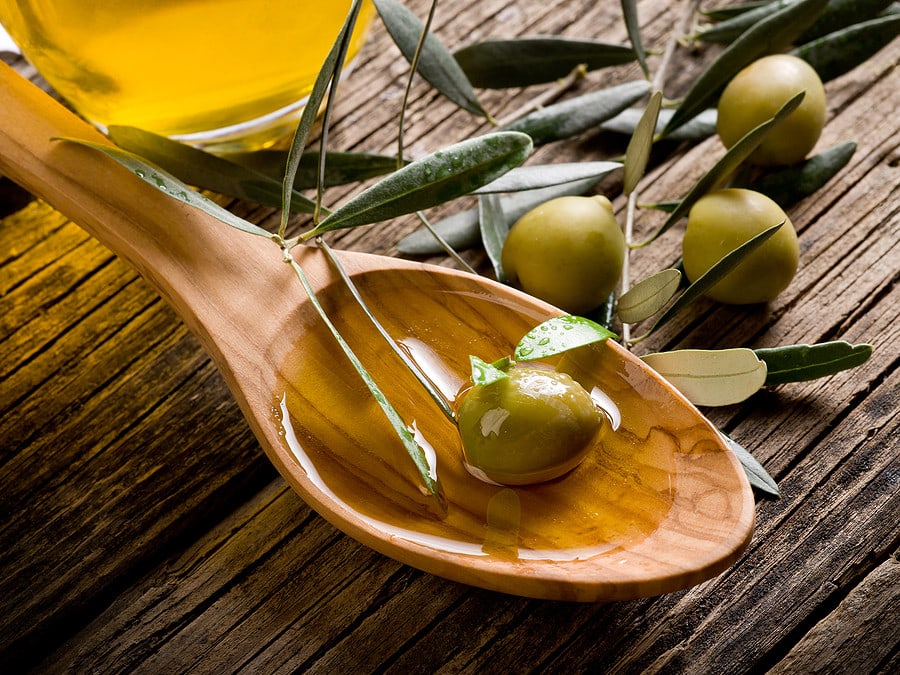
Strictly in terms of health benefits, extra virgin olive oil is the best choice.
When added to salads and used for cooking, EVOO provides heart-healthy fats, antioxidants, and flavonoids to support a healthy body. While it does have a lower smoke point, it is more stable than regular olive oil and vegetable oil and offers a range of additional benefits to the food you’re cooking.
The Best Olive Oil for Dipping Bread
One of the easiest ways to enjoy olive oil is to use it as a bread dip or topper. For this purpose, it’s best to use extra virgin olive oil. That’s because EVOO is the most flavorful option, since it is the purest and has not been exposed to heat or chemicals.
How to Make Bread Dipping Oil
If you’re looking for a quick way to elevate your dinner spread, whip up this bread dipping oil. It’s easy to make and customize!
You will need:
- Extra-virgin olive oil
- Minced garlic
- Fresh lemon juice
- Dried basil
- Dried parsley
- Dried oregano
- Dried thyme
- Red pepper flakes
- Salt
- Black pepper
- Vegan Parmesan cheese
You can also add dried rosemary, cilantro, or sage, as well a splash of balsamic vinegar.
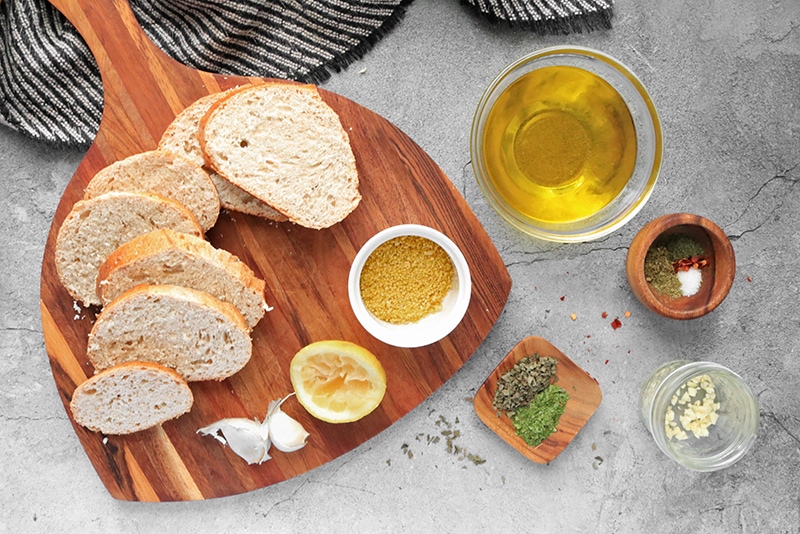
Combine all the ingredients in a bowl and whisk with a fork. Taste and adjust as necessary.
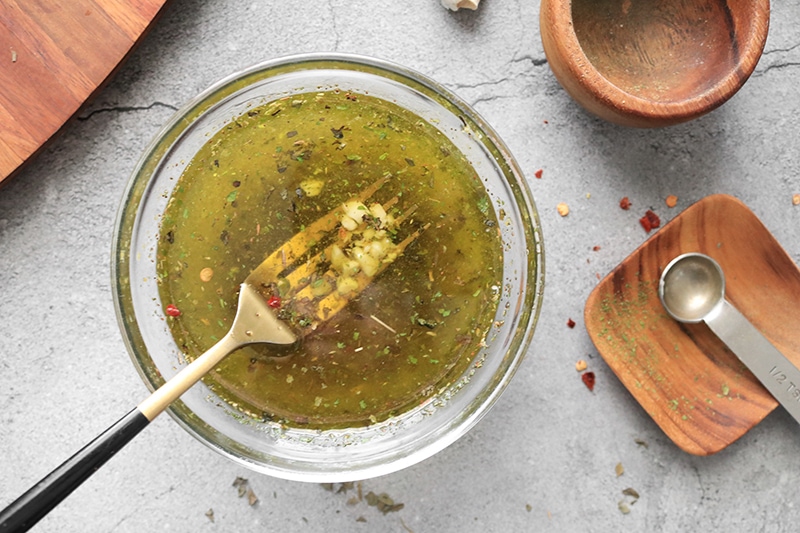
To serve, mix the oil to evenly disperse the spices. Scoop into shallow dishes or small bowls, then pair with warm toasted bread of your choice. Store the leftover oil in an air-tight jar in the refrigerator. Use within one week.
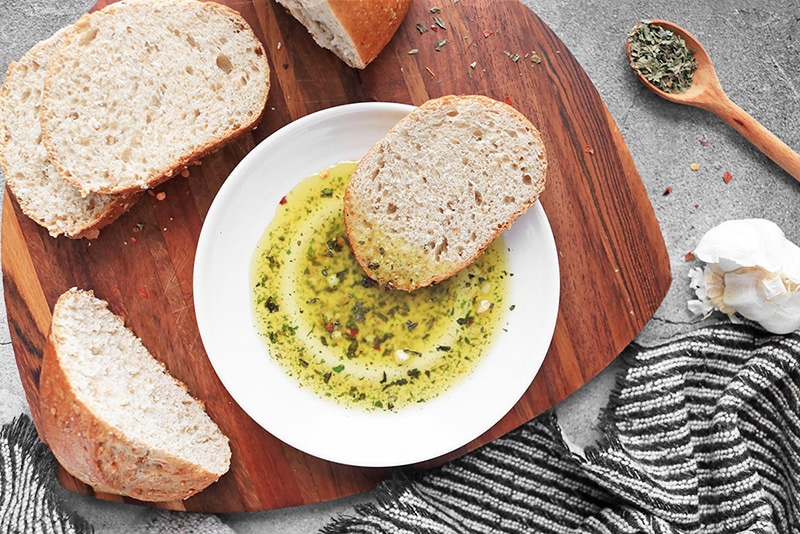
Note: Do not store the dipping oil at room temperature. Since it contains fresh garlic, doing so can increase the risk of botulism, according to the United States Department of Agriculture.
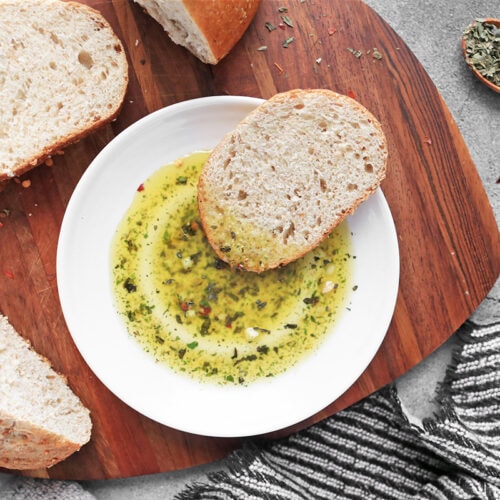
Bread Dipping Oil
Ingredients
- 1 cup extra-virgin olive oil
- 1 teaspoon lemon juice fresh
- 2 to 3 garlic cloves minced
- 2 to 3 tablespoons Vegan Parmesan cheese optional
- ½ tablespoon dried basil
- ½ tablespoon dried parsley
- ½ teaspoon dried oregano
- ½ teaspoon dried thyme
- ¼ teaspoon red pepper flakes
- ½ teaspoon salt
- ½ teaspoon ground black pepper
Instructions
- Combine all the ingredients in a bowl and whisk with a fork. Taste and adjust as necessary.
- To serve, mix the oil to evenly disperse the spices. Scoop into shallow dishes or small bowls, then pair with warm toasted bread of your choice. Store the leftover oil in an air-tight jar in the refrigerator. Use within one week.
Notes
- You can halve or double the recipe.
- Do not store the dipping oil at room temperature. Since it contains fresh garlic, doing so can increase the risk of botulism, according to the United States Department of Agriculture.
Nutrition
- How to Pick the Perfect Watermelon For a Sweet Summer Treat - April 10, 2024
- Future Kind’s Foundations: A Multivitamin Made for Vegans - December 5, 2023
- Does Nutritional Yeast Go Bad? - November 28, 2023


